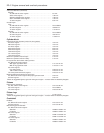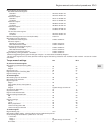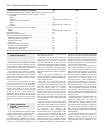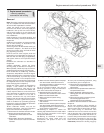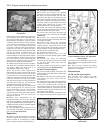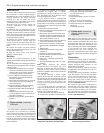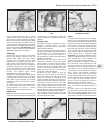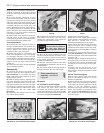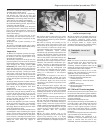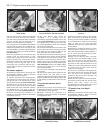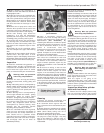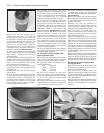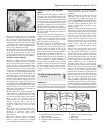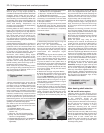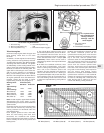
lifting the valve occasionally to redistribute the
grinding compound. A light spring placed
under the valve head will greatly ease this
operation.
22 If coarse grinding compound is being
used, work only until a dull, matt even surface
is produced on both the valve seat and the
valve, then wipe off the used compound, and
repeat the process with fine compound. When
a smooth unbroken ring of light grey matt
finish is produced on both the valve and seat,
the grinding operation is complete. Do not
grind-in the valves any further than absolutely
necessary, or the seat will be prematurely
sunk into the cylinder head.
23 When all the valves have been ground-in,
carefully wash off all traces of grinding
compound using paraffin or a suitable solvent,
before reassembling the cylinder head.
Valve components
24 Examine the valve springs for signs of
damage and discoloration. No minimum free
length is specified by Peugeot, so the only
way of judging valve spring wear is by
comparison with a new component.
25 Stand each spring on a flat surface, and
check it for squareness. If any of the springs
are damaged, distorted or have lost their
tension, obtain a complete new set of springs.
It is normal to renew the valve springs as a
matter of course if a major overhaul is being
carried out.
26 Renew the valve stem oil seals regardless
of their apparent condition.
Reassembly
27 Lubricate the stems of the valves, and
insert the valves into their original locations
(see illustration). If new valves are being
fitted, insert them into the locations to which
they have been ground.
28 Refit the spring seat then, working on the
first valve, dip the new valve stem seal in fresh
engine oil. Carefully locate it over the valve
and onto the guide. Take care not to damage
the seal as it is passed over the valve stem.
Use a suitable socket or metal tube to press
the seal firmly onto the guide (see
illustration).
29 Locate the valve spring on top of its seat,
then refit the spring retainer.
30 Compress the valve spring, and locate the
split collets in the recess in the valve stem.
Release the compressor, then repeat the
procedure on the remaining valves.
31 With all the valves installed, place the
cylinder head face down on blocks on the
bench and, using a hammer and interposed
block of wood, tap the end of each valve stem
to settle the components.
32 Refit the camshaft, followers and shims
(as applicable) as described in Part A, B or C
of this Chapter.
33 The cylinder head can then be refitted as
described in Part A, B or C of this Chapter.
7 Piston/connecting rod
assembly - removal and
inspection
4
Removal
XV, XW and XY series engines
1 With the cylinder head removed, unscrew
and remove the bolts which hold the
crankcase half sections together. Split the
crankcase and keep the main bearing shells
with their crankcase web recesses if the shells
are to be used again (see illustration).
2 Remove the crankshaft oil seal.
3 Mark the rim of the cylinder liners in respect
of their position and orientation in the block.
Note that No 1 cylinder liner is at the
transmission (flywheel) end of the engine.
4 Mark the big-end caps and the connecting
rods so that they can be refitted in their
original sequence and the correct way round.
A centre punch or hacksaw blade is useful for
this purpose.
5 Unscrew the big-end nuts and remove the
caps (see illustration). If the bearing shells
are to be used again, keep them taped to their
respective cap.
6 Using a hammer handle, push the piston up
through the bore, and remove it from the top
of the cylinder liner. Recover the bearing shell,
and tape it to the connecting rod for safe-
keeping.
7 Loosely refit the big-end cap to the
connecting rod, and secure with the nuts -
this will help to keep the components in their
correct order.
XU and TU series engines
8 Remove the cylinder head, sump and oil
pump as described in Part B or C of this
Chapter (as applicable).
9 Using a hammer and centre-punch, paint or
similar, mark each connecting rod and big-
end bearing cap with its respective cylinder
number on the flat machined surface
provided; if the engine has been dismantled
before, note carefully any identifying marks
made previously (see illustration). Note that
No 1 cylinder is at the transmission (flywheel)
end of the engine.
2D•10 Engine removal and overhaul procedures
6.27 Lubricate the valve stems prior to
refitting
6.28 Fitting a valve stem oil seal using a
socket
7.1 Undo the bolts and split the crankcase
half sections - XV, XW and XY series engines
7.5 Remove the big-end bearing caps 7.9 Marks made on connecting rod and
bearing cap - XU and TU series engines
Use a little dab of grease to
hold the collets in position on
the valve stem while the
spring compressor is released.



